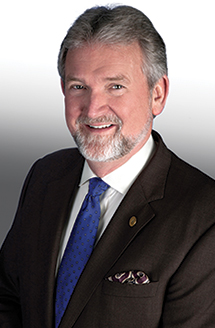Gene N. Herbek, MD
August 2014—It was my good fortune to be introduced to practice by a group of pathologists with a tradition of robust professional engagement. In residency or shortly thereafter, all of us joined the CAP, our state pathology society, state medical society, and the AMA because we were brought to understand it was the right thing to do. Explicitly and by example, mentors and partners have taught me a lot.
When I was a resident in pathology at the University of Nebraska Medical Center, C.A. McWhorter, MD, the 1969–1971 CAP president, was our department chair. Dr. McWhorter encouraged us to make a real commitment to organized medicine. “I can’t tell you to do it,” he said. “I can only tell you that it’s valuable, important, and rewarding.”

Dr. Herbek
John R. (“Rudy”) Schenken, MD, was a founding father of the CAP and the American Board of Pathology. His son, Jerald Schenken, MD, a member of the AMA Board of Trustees, often left encouraging notes in his younger colleagues’ mailboxes. I thought of Dr. Jerald Schenken during the AMA interim meeting in November, when Lauren Cooper King, MD, a hematopathology fellow at Houston Methodist Hospital, was elected an AMA Resident/Fellow Section delegate. Dr. King would have been on the receiving end of one of Dr. Schenken’s scribbled notes.
We are visible within the AMA; pathologists often serve in leadership posts. AMA president-elect Steven J. Stack, MD, who is a hospital-based physician, found time to sit down with our group for an informal conversation during this year’s meeting. James L. Caruso, MD, Denver’s chief medical examiner, is now chair-elect of the AMA Specialty and Service Society, the largest caucus within the AMA House of Delegates, representing more than 130 national medical societies, military service groups, and professional interest medical associations. (Dr. Caruso and Robert M. Wah, MD, who was sworn in as AMA president during the meeting, are fellow Navy veterans and old friends.)
James L. Madara, MD, AMA’s executive vice president/CEO, is a former president of the American Board of Pathology. While the AMA has always been committed to improving health care for all Americans, I like to think that the scope of strategic initiatives now underway may also reflect the scope of his interests as a pathologist. Did you know that the AMA commissioned a RAND study (http://j.mp/ama-rand) to look at factors that affect physician professional satisfaction? That two major initiatives to improve health outcomes are underway—one focused on uncontrolled hypertension and another to address the high prevalence of type 2 diabetes? That an AMA-organized consortium of medical schools is working to prepare the next generation of physicians for a technology-enabled team approach to patient care that targets chronic conditions and population health? All true.
I think everyone understands it is the quality of AMA advocacy around the concerns of all physicians that allows us to devote CAP advocacy resources to pathology-specific issues. Yet I have come to realize that some of our members have the mistaken idea that CAP membership defines the number of CAP delegate slots in the AMA House of Delegates. Allow me to clarify: The size of our delegation is determined by the number of CAP members who are also AMA members. The House of Delegates is medicine’s policymaking body, and your AMA membership is a vote for pathology.
 CAP TODAY Pathology/Laboratory Medicine/Laboratory Management
CAP TODAY Pathology/Laboratory Medicine/Laboratory Management
